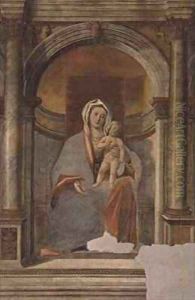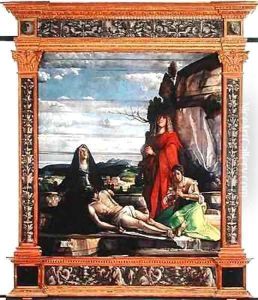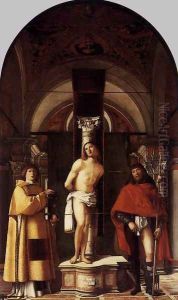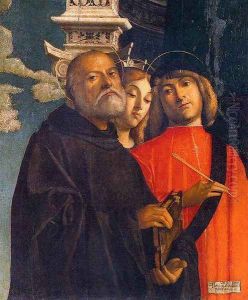Giovanni Buonconsiglio Paintings
Giovanni Buonconsiglio, also known as Giovanni il Marescalco or simply Il Marescalco, was an Italian painter of the Renaissance period, active mainly in Venice and Vicenza in the late 15th and early 16th centuries. Born around 1465, Buonconsiglio's work is noted for its blend of the Venetian coloristic tradition and the developing High Renaissance style. Despite his considerable talent, Giovanni Buonconsiglio remains one of the lesser-known figures of the Italian Renaissance, overshadowed by the era's giants like Leonardo da Vinci, Michelangelo, and Raphael.
Buonconsiglio's artistic journey is somewhat obscure, with limited documentation on his early life and training. It is believed that he may have been a pupil or follower of Giovanni Bellini, one of the most influential Venetian artists of the time, as his works exhibit a strong influence of Bellini's style, particularly in the use of color and light. Throughout his career, Buonconsiglio worked on a variety of commissions, including religious subjects for churches and portraits, showcasing his versatility and skill across different genres of painting.
In Vicenza, Buonconsiglio contributed significantly to the local artistic scene, executing altarpieces and frescoes that displayed both narrative depth and emotional intensity. His works often featured sophisticated use of perspective and were marked by their detailed landscapes and vibrant colors, characteristics that aligned him with the Venetian school's aesthetic preferences.
Despite his contributions to the Renaissance art movement, Giovanni Buonconsiglio's legacy has been somewhat eclipsed, and only a limited number of his works have been firmly attributed to him. However, his paintings continue to be studied and appreciated for their beauty and technical proficiency, offering insight into the transition between the Early and High Renaissance periods. Buonconsiglio is believed to have died around 1537, leaving behind a body of work that, though not as widely recognized as that of his contemporaries, plays a crucial role in the tapestry of Renaissance art.



